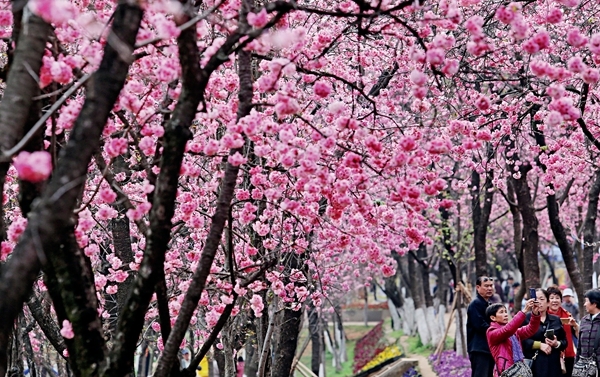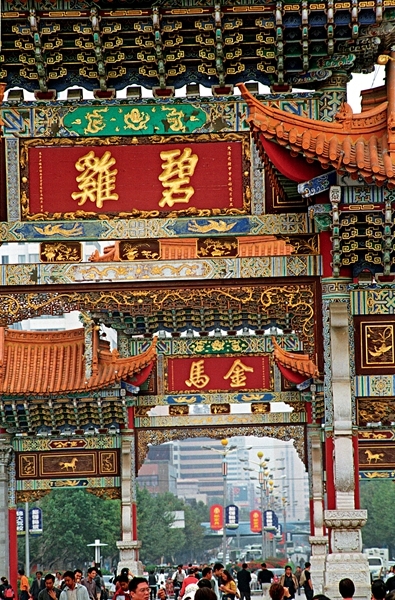Kunming: City of perpetual spring
 0 Comment(s)
0 Comment(s) Print
Print E-mail China Today, May 8, 2017
E-mail China Today, May 8, 2017
Kunming, the capital of Yunnan Province, sits on the Yunnan-Guizhou Plateau in southwestern China. A pivotal city in the region, and China’s gateway to Southeast and South Asia, for two millennia or more Kunming was a hub on the Southern Silk Road where merchants plied their trade and cultural and political exchanges took place.
|
|
|
On March 18, 2017, Yuantong Mountain Sakura Festival showcases the beauty of spring in Kunming. |
Kunming basks in balmy weather and glorious natural scenery. The city is surrounded by mountains on three sides and on the other lies Dianchi Lake, the largest lake in the province. The temperature is mild all year round, and plants take turns to blossom in all four seasons, earning Kunming the nicknames of City of Perpetual Spring and City of Flowers.
Multi-ethnic Habitat
Historians have different theories on the origins of Kunming’s name, but it is generally believed to be the name of an ancient ethnic group from southwestern China.
In 1965 archaeologists discovered two incisors, the remains of the “Yuanmo man” in the eponymous county 170 km northwest of Kunming. He is believed to have lived 1.7 million years ago, and is hence China’s oldest known inhabitant. Ancient peoples settled on the shores of Dianchi Lake around 4,000 years ago, and lived by farming, hunting, and herding.
In the first century AD, the Han Dynasty (206 BC - AD 220) extended its authority to the country’s southwestern borders, setting up a local government body in the region around Dianzhi Lake. Yunnan later came under the direct control of the central government. As Han people migrated there, bringing with them advanced inland technologies and culture, Yunnan became more economically developed. China’s reunification under the Yuan Dynasty (1271-1368) saw the establishment in 1276 of the Yunnan Branch Secretariat (provincial administrative unit), which transformed Kunming into a political, economic and cultural center.
For centuries, Kunming has been home to 26 ethnic groups, including the Han, Yi, Hui and Bai. Having lived and worked side by side, these peoples interacted and became familiar with one another’s folklore while preserving their respective culture and customs, apparent in their distinctive traditional costumes, homes and food.
The fragmented stone slabs in the woods of Jiaoye Park in Kunming’s western suburbs, their surface pitted with hoof marks, are the remains of the ancient Tea-Horse Trail between Yunnan, Sichuan, and Tibet. This was a main trade route in earlier times, when the first caravans to enter Tibet from the two regions traded tea for horses and medicinal herbs.
Local ethnic groups have nurtured their distinct cultures in the enclaves created by southwestern China’s highland terrain of mountains and crisscrossing rivers. It was the Tea-Horse Trail that connected them, making possible exchanges, interaction and mutual assimilation, and creating a trove of diverse cultures.
WWII Feats
Kunming holds a prominent position in China’s WWII history. After invading China in 1931, Japanese troops successively occupied the northern and coastal regions. It was left to Kunming to bring up the rear of the Chinese people’s armed resistance.
|
|
|
Jinma Biji Archway is a Kunming landmark. |
After the Pacific War broke out in 1941, Japanese forces seized Myanmar and advanced to western Yunnan to attack and occupy the 30,000 sq km of Chinese territory west of the Nujiang River. Yunnan then became the vanguard of resistance against Japanese aggression.
Japanese troops occupied major coastal Chinese cities, including Tianjin, Shanghai, Guangzhou, Shantou, and Hainan Island, and severed international transport routes between China and the rest of the world from Hong Kong. Passages through southwestern China thus became the lifeline supply for the country’s battle against Japanese invaders. The Yunnan-Vietnam Railroad, the Burma Road, the Hump, the Stilwell Road, and an oil pipeline between China and India all ran across Yunnan, playing a critical role in the battle against Japanese aggression.
Kunming was the take-off and landing point for the so-called Hump, the name allied pilots gave to the eastern end of the Himalayas over which they flew military transport aircraft between India and China to resupply the Chinese war effort.
Initiated in 1942, Hump airlifts continued through to the end of the war. The route is 500 miles long and 7,000 meters above sea level at its highest point. Pilots flying the Hump needed to negotiate snow-capped mountains, icy valleys, tropical forests, primeval forests, and Japan-occupied areas. Constant turbulence, low pressure, and often being weighed down by ice made flights even more perilous. But these airlifts enabled China to assign soldiers to India to fight Japanese invaders abroad, and to import vital war supplies of gasoline and weapons.
The Hump was the most dangerous air transportation in world war history. It claimed the lives of around 3,000 American pilots, and cost the U.S. more than 1,500 planes – around 80 percent of its total planes and air crew serving this route. China lost 48 planes and 168 pilots, around half of its total air force.
The plane debris in the valleys below the Hump gave rise to the epithet Valley of Aluminum, where twisted metal shards glinted in the sun. Local people did what they could to help when American planes crashed. The Hump exacted a heavy human toll of Chinese and American airmen who willingly risked their lives in the war against Fascism.
A 10-meter-tall Memorial to the Hump Airlift now stands in Jiaoye Park in tribute to these men. From afar, it resembles a plane about to take flight. It stands witness to the effort and sacrifice, as well as friendship between those brave Chinese and American airmen.
City of Perpetual Spring, Capital of Flowers
Kunming is famed for its perpetual spring, and flowers that take turns to blossom. Chinese ancients constantly lauded Kunming for these attributes, so highlighting its uniqueness.
Kunming’s geographical location endows it a climate of constant spring. With an average temperature of around 15 degrees Centigrade and little variance in temperatures throughout the four seasons, it merits its City of Perpetual Spring sobriquet.
Plants and flowers thrive in Kunming’s mild climate of ample sunshine and rainfall. Whether in a park, on a hillside, in a yard, or even on a balcony, you are certain to be surrounded by blooms the whole year round. As people say, in Kunming, not a day goes by when a flower does not blossom.
Visitors to Kunming will be glad they took the time to stroll along Shangyi Street, the most romantic thoroughfare in Kunming’s history, because there can be seen a glorious profusion of flowers. In the mid-1980s, horticulturalists from suburban Kunming went there to sell their flowers. With the passing of time, sellers and vendors proliferated and a market was born. After 10 or more years’ development, the Shangyi flower market became famous both at home and abroad. An ideal place for locals to buy and appreciate flowers, it was also a favorite spot for visitors seeking floral mementos of Kunming. Now relocated to Lianmeng Road, it is a truly professional flower market.
People who know and love flowers not only grow and appreciate them, but have also created an industry from their passion. The flower market in Dounan Village of Chenggong County, 18 km from the center of Kunming, is the biggest of its kind in China, and leads the country’s wholesale flower industry. There are 400 hectares of land in Dounan Village devoted to flower growing, and 200 varieties in more than 50 species go to market. They are sold to 10 other big cities in China, and are also exported to Japan, Singapore, and Thailand. The night flower market, with it bustle and vitality, is not to be missed.
Taking a walk through the flower market, enjoying a bowl of colored rice dyed with flowers, luxuriating in a flower bath, and gazing at flower floats are among the many delights a trip to Kunming offers. The snow-white magnolia flowers in the West Hill Forest Park, the elegant orchids blooming in the Xihuayuan Garden, the weeping willows and swaying lotuses in the Cuihu Park – all are sure to enchant travelers from home and abroad.







